|
Roy H. Duncan
Headquarters Company, 21st Armored Infantry Battalion
11th Armored Division, Third Army
Photo
Gallery-click here
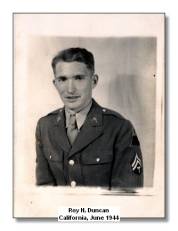
After Trip Report
Retracing My Steps
Accompanied By:
Jane Duncan (daughter)
Jewel Duncan Collett (daughter)
Brandon Duncan (grandson)
From September 29th through October 19th, 2006 we had the privilege to embark on a trip to Europe to visit areas where I served as part of the 11th Armored Division during 1944 and 1945.
A trip to Europe was discussed for many years, but was always delayed due to the schedules of daily life. Finally in the spring of 2006, it was decided it was time for the trip. My Grandson, Brandon, who began discussing and planning the trip with me, decided to join me. Later, two of my children, Jane and Jewel, decided to make the journey with us.
Planning the trip brought us together for meetings, along with numerous telephone calls, printing pages from the 11th Armored Division web site, buying and studying maps and researching locations on the Internet.
Finally the day arrived for our departure on September 29th from St. Louis, MO, airport. We connected in Detroit to our flight to Frankfurt, Germany and arrived at Frankfurt on the morning of September 30th. After picking up our rental car, we drove to Bastonge, Belgium where we were warmly welcomed at the Best Western Hotel.
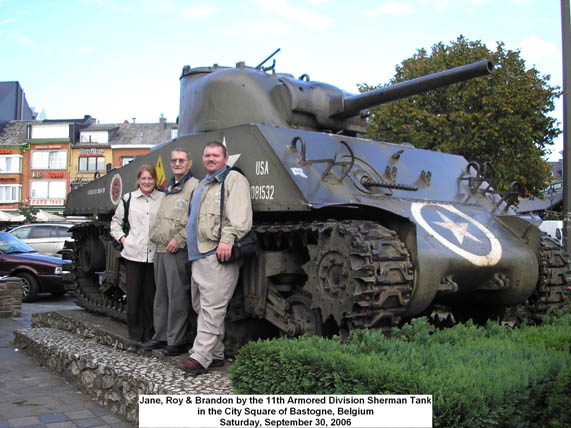
Saturday Sept. 30th
While adjusting to the time change from our trip to Europe we strolled the City Square in
Bastogne viewing and taking photos of an 11th Armored Sherman tank, jeep and the bust of General McAuliffe.
Sunday, Oct. 1st
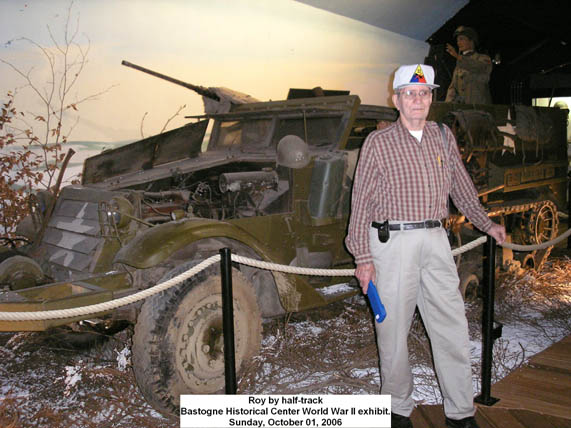 While in Belgium and Luxembourg I wore my 11th Armored Division cap. We visited the First Museum of War Artifacts in Bastogne. In the Museum, were two young Belgian boys about 14 and 16 years old that asked one of my daughters if I had been in the war. She told them I had and they asked if they could shake my hand. They shook my hand and said “Thank you – Thank you”. My daughter said the boys were excited when they learned I had been in the war. We also saw a package marked with “Paducah – Louisville Tobacco” which was of special interest to me since I’ve lived my entire life in Paducah, Kentucky. We then visited the Bastogne Historical Center, the Memorial on Mardasson Hill and took photos by The Stones of Liberty Way.
While in Belgium and Luxembourg I wore my 11th Armored Division cap. We visited the First Museum of War Artifacts in Bastogne. In the Museum, were two young Belgian boys about 14 and 16 years old that asked one of my daughters if I had been in the war. She told them I had and they asked if they could shake my hand. They shook my hand and said “Thank you – Thank you”. My daughter said the boys were excited when they learned I had been in the war. We also saw a package marked with “Paducah – Louisville Tobacco” which was of special interest to me since I’ve lived my entire life in Paducah, Kentucky. We then visited the Bastogne Historical Center, the Memorial on Mardasson Hill and took photos by The Stones of Liberty Way.
Monday Oct. 2nd
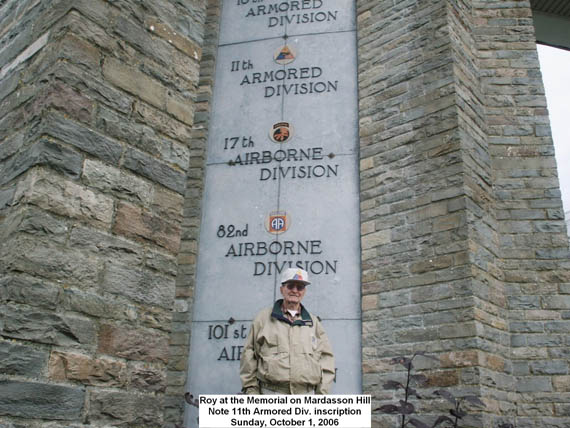 We met Mr. Michel Baert, a local guide who specializes in tours for the Battle of the Bulge. Mr. Baert took us through St. Hubert, Belgium where I remember being in 1944. In 1944 we investigated that town, but found nothing. He then guided us to Singly, France, a small hamlet that doesn’t appear on any maps. We also drove through Ilily, France. Near Singly is where our company made final preparations before heading into our first action near Chenogne, Belgium. It is hard to remember
Sedan, Singly or any other villages, because in 1944, the ground and building were covered with snow or partly destroyed, because they had already seen battles.
We met Mr. Michel Baert, a local guide who specializes in tours for the Battle of the Bulge. Mr. Baert took us through St. Hubert, Belgium where I remember being in 1944. In 1944 we investigated that town, but found nothing. He then guided us to Singly, France, a small hamlet that doesn’t appear on any maps. We also drove through Ilily, France. Near Singly is where our company made final preparations before heading into our first action near Chenogne, Belgium. It is hard to remember
Sedan, Singly or any other villages, because in 1944, the ground and building were covered with snow or partly destroyed, because they had already seen battles.
It was wonderful to see that the towns had been rebuilt. We couldn’t see any evidence of the battles that had taken place. On this trip, we traveled some of the same roads we did in 1944, but in 1944, we sometimes traveled through the fields, as the roads were mined and hadn’t been cleared. The forests looked the same, but this time, the snow wasn’t present. It was a very good feeling to see how the towns and streets had been repaired and rebuilt and see normal activities of the people. As we passed from town to town, it was difficult to remember all the destruction that had taken place. The people were friendly. Whenever our guide mentioned to them that I had been here before, they gave me a big smile, and some of them wanted to shake my hand. The people were glad that we came when we did.
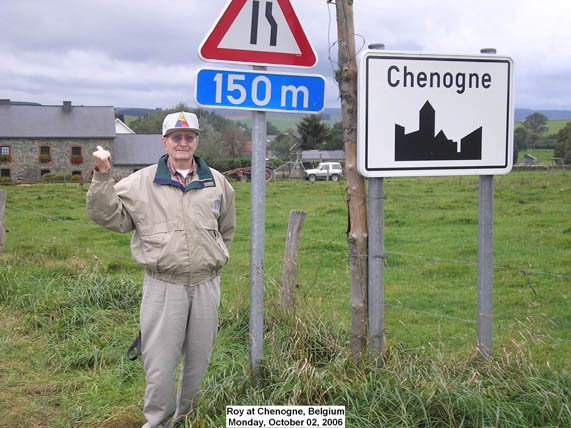 The guide explained to us where the 11th Armored had been in 1944. But I remember that we sometimes didn’t know where we were except on the way to the battle zones. We visited Chenogne, Belgium, and saw the monument that honors citizens of Chenogne who lost their lives during the battle from December 30, 1944 through January 1, 1945. In 1944 when we came near Chenogne, Belgium, we didn’t know the name of the town, but only that is where the Germans were. I remember we were led down the wrong road and suffered many casualties, a few from our own company. Three were killed and others were wounded. Snow was on the ground as we withdrew to a small wooded area where we were for a day, before we were again on the attack. We withdrew for the night on the next day, and then went out again to drive the Germans back.
The guide explained to us where the 11th Armored had been in 1944. But I remember that we sometimes didn’t know where we were except on the way to the battle zones. We visited Chenogne, Belgium, and saw the monument that honors citizens of Chenogne who lost their lives during the battle from December 30, 1944 through January 1, 1945. In 1944 when we came near Chenogne, Belgium, we didn’t know the name of the town, but only that is where the Germans were. I remember we were led down the wrong road and suffered many casualties, a few from our own company. Three were killed and others were wounded. Snow was on the ground as we withdrew to a small wooded area where we were for a day, before we were again on the attack. We withdrew for the night on the next day, and then went out again to drive the Germans back.
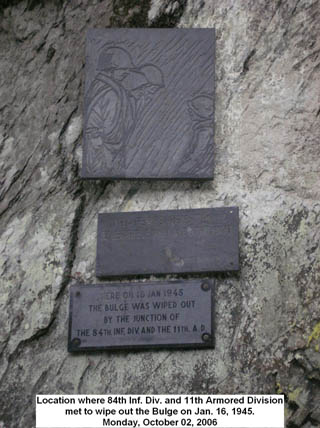 Somewhere in this area we were attacking during the night. I had a radio on my back and we were getting a heavy barrage of artillery from the Germans. The next thing I know is that I woke up dazed in an ambulance. I was very fortunate. When in the hospital, I was told I only had some loose teeth but they would be OK. I was also told the radio I was carrying was destroyed. I was back with my unit in a few days. On this trip we went down many roads that I’m sure we were on in 1944-45, because we were always on the move.
Somewhere in this area we were attacking during the night. I had a radio on my back and we were getting a heavy barrage of artillery from the Germans. The next thing I know is that I woke up dazed in an ambulance. I was very fortunate. When in the hospital, I was told I only had some loose teeth but they would be OK. I was also told the radio I was carrying was destroyed. I was back with my unit in a few days. On this trip we went down many roads that I’m sure we were on in 1944-45, because we were always on the move.
Our guide took us to a location where three plaques are displayed. One plaque shows four soldiers, another had wording in another language, and on the third was inscribed, “Here on 16 January 1945 the Bulge was wiped out by the junction of the 84th Infantry Division and 11th Armored Division.
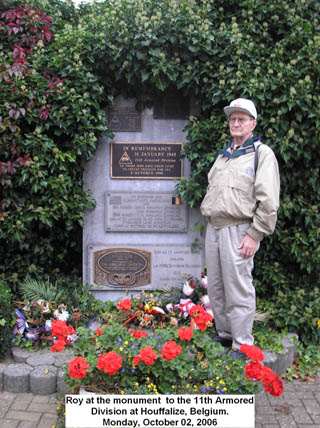 We went to Houffalize, Belgium and visited the monument to the 11th Armored Division. We saw the German Panther Mark V tank that had been left upside down in the river Ourthe for some time, but was now upright at a park. Our guide said Houffalize was 90% destroyed. I remember being in Houffalize. In 1944, most of the towns we were in were still smoking from the bombardment that the Germans and Allies gave the town. It was hard for me to remember any towns that we went through. We knew we had been there, but we only saw the signs once as we passed through, and then we saw them no more. But, we were told these were the towns that we went through.
We went to Houffalize, Belgium and visited the monument to the 11th Armored Division. We saw the German Panther Mark V tank that had been left upside down in the river Ourthe for some time, but was now upright at a park. Our guide said Houffalize was 90% destroyed. I remember being in Houffalize. In 1944, most of the towns we were in were still smoking from the bombardment that the Germans and Allies gave the town. It was hard for me to remember any towns that we went through. We knew we had been there, but we only saw the signs once as we passed through, and then we saw them no more. But, we were told these were the towns that we went through.
Our guide took us to Noville, Belgium. When the Germans reoccupied this area as part of the Bulge, they rounded up all of the people they knew were resistance fighters and the German SS executed them. We visited the cemetery honoring these local resistance fighters. Our guide also wanted to take us to a place in this area where foxholes still exist, but it was too dark and late in the day.
After we left our tour guide, and while waiting to be seated for dinner in a Bastogne restaurant, a Scottish gentleman came over and asked if I was with the 11th Armored Division. He was so glad I was here. He is also a tour guide for the Battle of the Bulge area and Battle for Bastogne and had some gentlemen with him from Boston. He and the gentlemen from Boston came over, shook my hand and thanked me and all who helped liberate Belgium. Bastogne was a friendly town. Even while walking down the street people would smile at us.
When we arrived back at our hotel in Bastogne, we asked the hotel manager to call and inquire if the church in Lieler, Luxembourg, would be open tomorrow. They graciously arranged for the church to be open and informed us that a local couple in Lieler had invited us to their home.
Tuesday Oct. 3rd
While we ate breakfast at our hotel, Mr. Henri Megon stopped by. Mr. Megon is also a Battle of Bulge tour guide that we had previously met. He presented me with a 60th Anniversary medal of the Battle of Ardennes. He also gave me a book of photographs named “The Battle of the Bulge” which contains over 100 photos showing how the towns of Bastogne, La Roche, Bodange, Neufchateau & Houffalize suffered during the war. We gave Mr. Megon some gifts we had brought from home to present to Mr. Michel Baert, our tour guide yesterday.
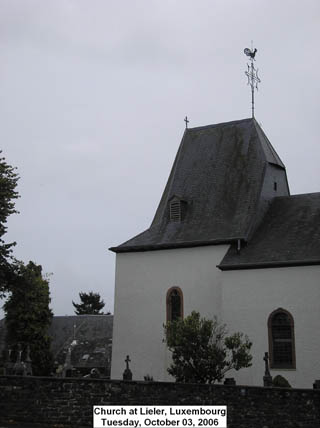 After breakfast we left for Lieler, Luxembourg. The church at Lieler was open for us to visit and take pictures. It made me feel good to see that the church was still standing and hadn’t been destroyed. I specifically remember this church, because in 1945, the women parishioners of this church embroidered special handkerchiefs for US soldiers. The handkerchiefs were made from US parachutes. The center of the handkerchief shows the outline of Luxembourg with the sun rising within the outline and the sun labeled with USA. The location of Lieler is marked on the outline map of Luxembourg. Surrounding the map are embroidered “1945” “Liberator Soldier” “Thank You” “To my wife” and “From Roy”. The outside edge of the handkerchief is also embroidered. The ladies had asked us our names the night before they gave us the handkerchief. This means they embroidered the handkerchiefs at night to present to us the next day. I still have this handkerchief.
After breakfast we left for Lieler, Luxembourg. The church at Lieler was open for us to visit and take pictures. It made me feel good to see that the church was still standing and hadn’t been destroyed. I specifically remember this church, because in 1945, the women parishioners of this church embroidered special handkerchiefs for US soldiers. The handkerchiefs were made from US parachutes. The center of the handkerchief shows the outline of Luxembourg with the sun rising within the outline and the sun labeled with USA. The location of Lieler is marked on the outline map of Luxembourg. Surrounding the map are embroidered “1945” “Liberator Soldier” “Thank You” “To my wife” and “From Roy”. The outside edge of the handkerchief is also embroidered. The ladies had asked us our names the night before they gave us the handkerchief. This means they embroidered the handkerchiefs at night to present to us the next day. I still have this handkerchief.
A local lady at the church was aware that we were to visit a local couple, and she give us directions to their home. We walked to the home of Jean & Marie Pieree. They were very gracious and invited us into their home. Using a little French, German and a lot of English we conversed with them. Mr. & Mrs. Pieree told us they had also invited the Mayor of Lieler over to meet us.
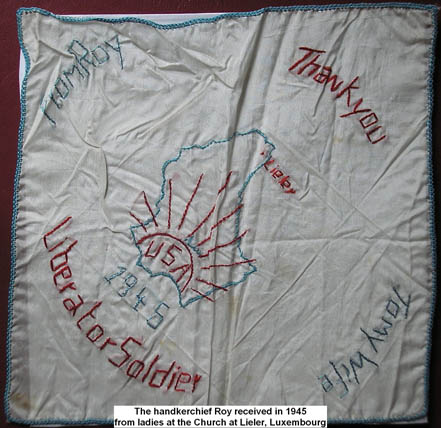 The Mayor, Mr. Thielen Roymond, arrived and assisted in translating for us. Mrs. Pieree told us that she had two uncles and an aunt that were taken and sent to the Mauthausen Concentration Camp in Austria, and were never heard from again. I told them that on this trip I brought a pound a coffee to give to the priest at the church. In 1945 we had asked the priest at the church if he needed anything. He said he had not had coffee for some time. We liberated some coffee from our kitchen and gave it to him. The priest in turn gave us two bottles of wine. He told us that the wine had been blessed. I remember telling the priest that we needed all the help that we could get. Since there is no longer a full time priest at this church, I gave the pound of coffee and a picture of the handkerchief to Mr. & Mrs. Pieree. Mr. Pieree then left the room for a few minutes. When he returned he gave me a bottle of 1999 Luxembourg wine.
The Mayor, Mr. Thielen Roymond, arrived and assisted in translating for us. Mrs. Pieree told us that she had two uncles and an aunt that were taken and sent to the Mauthausen Concentration Camp in Austria, and were never heard from again. I told them that on this trip I brought a pound a coffee to give to the priest at the church. In 1945 we had asked the priest at the church if he needed anything. He said he had not had coffee for some time. We liberated some coffee from our kitchen and gave it to him. The priest in turn gave us two bottles of wine. He told us that the wine had been blessed. I remember telling the priest that we needed all the help that we could get. Since there is no longer a full time priest at this church, I gave the pound of coffee and a picture of the handkerchief to Mr. & Mrs. Pieree. Mr. Pieree then left the room for a few minutes. When he returned he gave me a bottle of 1999 Luxembourg wine.
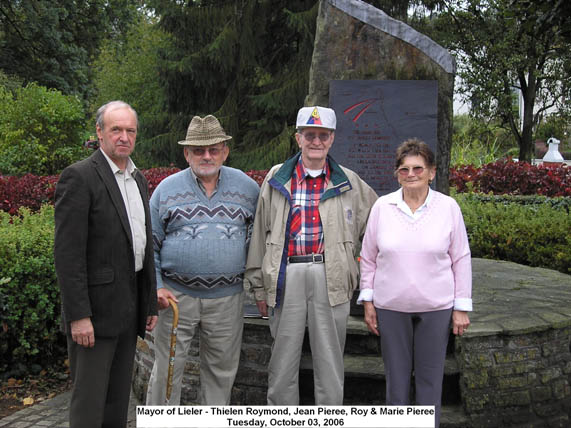 The Mayor then drove Mr. & Mrs. Pieree and me for a tour of Lieler and took us to a location where the Luxembourg, Belgium and Germany borders meet. This area is like a park, with numerous monuments and to our understanding, commemorates the beginning of the European Union in the 1950s. We continued our visit with them and took pictures at this location. We told them we were going to try to find Hill 568. We bid them good-bye and they thanked me and the 11th Armored Division for what we did while we were in Luxembourg.
The Mayor then drove Mr. & Mrs. Pieree and me for a tour of Lieler and took us to a location where the Luxembourg, Belgium and Germany borders meet. This area is like a park, with numerous monuments and to our understanding, commemorates the beginning of the European Union in the 1950s. We continued our visit with them and took pictures at this location. We told them we were going to try to find Hill 568. We bid them good-bye and they thanked me and the 11th Armored Division for what we did while we were in Luxembourg.
We then crossed the Ouren River, a river that we crossed many times in 1945, and also on this trip.
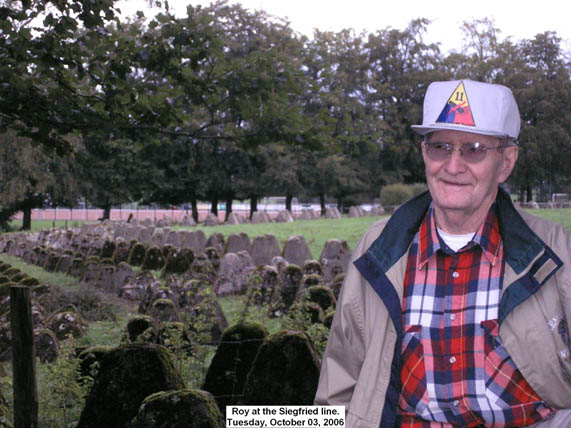 While driving around looking for Hill 568 we stopped to study our maps and noticed “dragons teeth” of the Siegfried line. At this location there is an information board describing the “West Wall”, as the Germans called it, or the Siegfried line. The “dragons teeth” appear to run for about one half mile and are located about two miles, probably to the east, of Hill 568. After taking photos of the “dragons teeth”, we drove up and down many roads around Hill 568. I was looking for something that I could use to identify where I had been on the hill in 1945. But, we never found what I thought was the exact location. I was looking for a road with a certain slope, where a group of us had been when shots were being fired. I remember I was trying to use sapling tree for cover.
While driving around looking for Hill 568 we stopped to study our maps and noticed “dragons teeth” of the Siegfried line. At this location there is an information board describing the “West Wall”, as the Germans called it, or the Siegfried line. The “dragons teeth” appear to run for about one half mile and are located about two miles, probably to the east, of Hill 568. After taking photos of the “dragons teeth”, we drove up and down many roads around Hill 568. I was looking for something that I could use to identify where I had been on the hill in 1945. But, we never found what I thought was the exact location. I was looking for a road with a certain slope, where a group of us had been when shots were being fired. I remember I was trying to use sapling tree for cover.
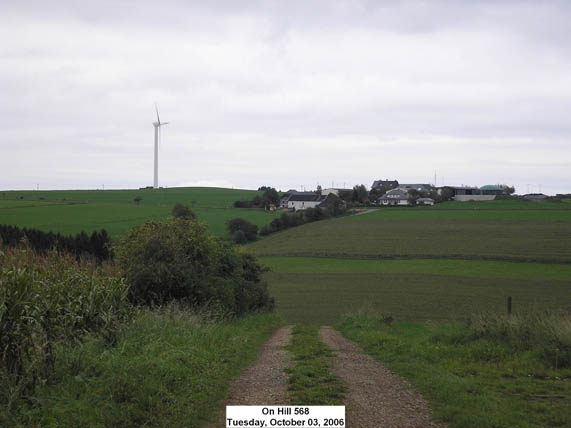 We drove on a dirt farm road along the crest of Hill 568 for about two miles. From the top you could see for miles. This area is now farmland and has many of the tall wind generators used for generating electricity. While on the hill, we saw many small pieces of concrete in the fields. We concluded that these were remnants of the bunkers or pillboxes that had been destroyed.
We drove on a dirt farm road along the crest of Hill 568 for about two miles. From the top you could see for miles. This area is now farmland and has many of the tall wind generators used for generating electricity. While on the hill, we saw many small pieces of concrete in the fields. We concluded that these were remnants of the bunkers or pillboxes that had been destroyed.
In 1945, all of this area was covered with six to twelve inches of snow. I remember we were able to walk through the Siegfried line and dig-in on Hill 568. All three of the 11th Armored’s Infantry Battalions were involved in taking and holding this hill. To our left was the 90th Division. That night, for about two hours, we heard music and invitations to come over for coffee, donuts and a warm bed, from an area of woods on another hill. The music and invitations ceased when our artillery made them move their coffee maker so it wouldn’t be destroyed. The next day our guys saw a two story building that they thought could be a spot for a forward observer so our artillery took it out.
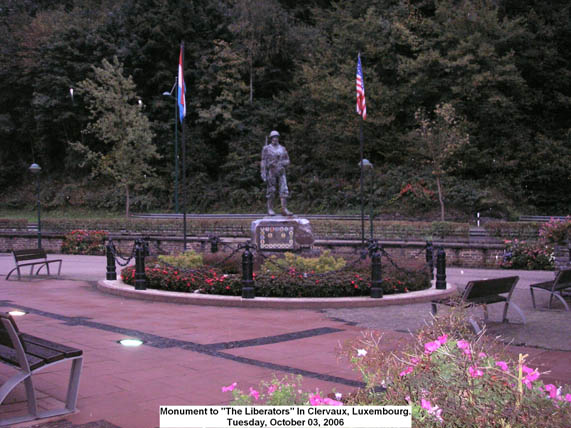 After leaving Hill 568, we went to Clervaux, Luxembourg, and visited a monument to "The Liberators". The monument includes a statue of a GI and displays the patches of all the US units that helped liberate Luxembourg, including the 11th Armored. While having dinner at Clervaux, a gentleman from the Netherlands spoke to me. He thanked me and our country for what we had done and the sacrifices we made to liberate Europe and their country. We had a very nice visit with this gentleman.
After leaving Hill 568, we went to Clervaux, Luxembourg, and visited a monument to "The Liberators". The monument includes a statue of a GI and displays the patches of all the US units that helped liberate Luxembourg, including the 11th Armored. While having dinner at Clervaux, a gentleman from the Netherlands spoke to me. He thanked me and our country for what we had done and the sacrifices we made to liberate Europe and their country. We had a very nice visit with this gentleman.
What really impressed me in Belgium and Luxembourg was that the younger generation, those that were kids during the war, recognized the armored division’s triangle patches. They would say, “Oh, you were with the 11th Armored Division”. The fact that the younger generations knew that my generation had been there made me feel good. This was really something special to me.
We were all so impressed and it made us feel very welcome when complete strangers would come up to my family and me and talk to us.
When we returned to our hotel, we met and talked to two US intelligence soldiers, one from the Air Force and the other from the Navy, who research those Missing In Action from WWI and WWII.
Wednesday Oct. 4th
Today we were leaving Bastogne. Before we left, we placed an 11th Armored Division patch in the hotel guest book that my family and I signed. The people that operate the Bastogne Best Western hotel made us feel very welcome and at home. They had made arrangements for our trip to Lieler, even prepared sack lunches for us, and then wouldn’t accept payment. We gave the hotel staff gifts we had brought from home to thank them for their hospitality.
We left Bastogne and headed for Luxembourg City to tour the Patton Museum. After many roundabouts we arrived at the museum. There, we learned that during the winter, the Patton Museum is only open on Sunday from 2PM to 4PM, or by special appointment. So, we were not able to tour the museum. We then went to the National Military Museum in Diekirch, Luxembourg. When we arrived, we again met the gentleman from Scotland that we had met earlier in a Bastogne restaurant. The Scottish gentlemen informed the museum staff that I was a veteran with the 11th Armored. They asked me to register and then the museum curator presented me with a medal from the Luxembourg Government. The medal is in the shape of a star, inscribed with “Liberation of Luxembourg”, “A Tribute to Veterans”, “60th Anniversary”.
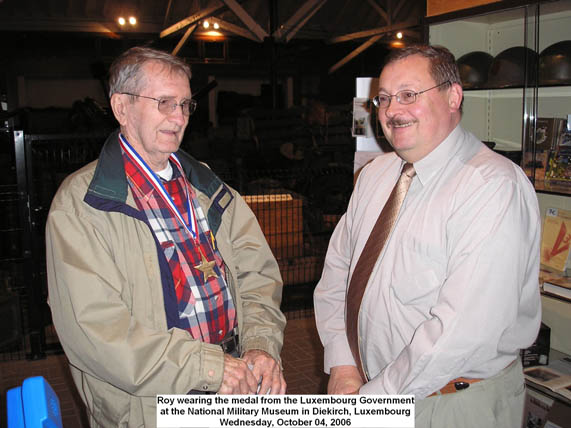 After I received the medal, I was speaking with two women that work at the museum. I told them about the embroidered handkerchief that we received, in 1945, from the women parishioners at the church in Lieler, Luxembourg. They had heard about them, but had never seen one, or even a picture of one. After we toured the museum, I retrieved a picture of the handkerchief from the car and gave it to the two women. They called over the museum curator. He also said he had heard about them but had never seen one. I also gave them an 11th Armored Division. patch. They were very pleased to receive the picture and patch and thanked me.
After I received the medal, I was speaking with two women that work at the museum. I told them about the embroidered handkerchief that we received, in 1945, from the women parishioners at the church in Lieler, Luxembourg. They had heard about them, but had never seen one, or even a picture of one. After we toured the museum, I retrieved a picture of the handkerchief from the car and gave it to the two women. They called over the museum curator. He also said he had heard about them but had never seen one. I also gave them an 11th Armored Division. patch. They were very pleased to receive the picture and patch and thanked me.
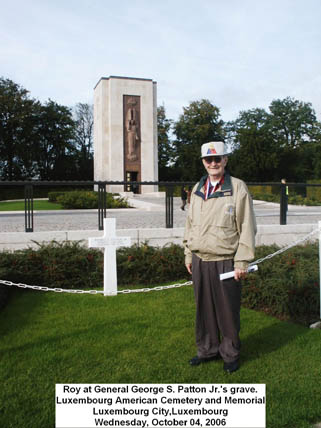 We left the museum and headed to the Luxembourg American Cemetery and Memorial in Luxembourg City, Luxembourg. We found the drive through Luxembourg City very interesting and challenging. We walked around the cemetery, looked at the maps of troop movements and the chapel, and visited General Patton’s grave. A group of Asian teenage students were also at the Cemetery. One of the young men came over and asked me if he could take my picture. I told him yes, but we can take our picture together. After the picture, he said, “You’re a hero, I want to shake your hand” so he did. Soon after another young man also wanted his picture taken with me. We spent about one and a half hours at the Cemetery until they played Taps and it was closing. We found the Cemetery very clean and well kept. We could not see a wilted rose pedal on any of the roses. We also received a pamphlet about the Cemetery. We found the visit here to be a very solemn and moving experience.
We left the museum and headed to the Luxembourg American Cemetery and Memorial in Luxembourg City, Luxembourg. We found the drive through Luxembourg City very interesting and challenging. We walked around the cemetery, looked at the maps of troop movements and the chapel, and visited General Patton’s grave. A group of Asian teenage students were also at the Cemetery. One of the young men came over and asked me if he could take my picture. I told him yes, but we can take our picture together. After the picture, he said, “You’re a hero, I want to shake your hand” so he did. Soon after another young man also wanted his picture taken with me. We spent about one and a half hours at the Cemetery until they played Taps and it was closing. We found the Cemetery very clean and well kept. We could not see a wilted rose pedal on any of the roses. We also received a pamphlet about the Cemetery. We found the visit here to be a very solemn and moving experience.
We left the Cemetery and headed to Cochem, Germany along the Mosel River.
Thursday Oct. 5th
This was an R&R day. We really enjoyed staying in Cochem, a very beautiful little town with vineyards all around and a castle near the top of the river valley. We made a brief site seeing trip to the Eltz castle, a castle that has been in the same family for over 800 years.
Friday Oct. 6th
We backtracked a little to get back on our original route to visit Prum and then the Rhine River at Andernach, Germany.
In 1945, Prum was a German stronghold and we were to take a bridge over the Rhine near Andernach. But the roads were cluttered with German and civilian equipment. Civilians, and the Germans were trying to cross the Rhine to escape. All this clutter slowed our progress, so we arrived late. While we were at Andernach, we were regrouping for two or three days. Then they changed our direction and we headed south and crossed the Mosel River. We then headed to Worms to cut off another segment of the Germany army that was trying to retreat across the Rhine at Worms. The First Army was on our right side and we met up with the First at Worms. We cut off a large segment of the Germany Army that didn’t make it back across the Rhine. We patrolled the area until they got the bridges built to cross the Rhine.
After seeing how the cities in Belgium and Luxemburg had been rebuilt, I expected the same for the towns and cities in Germany, which was the case. One saw no signs that a war had occurred here over 60 years ago.
Leaving Andernach, we returned to Cochem for the night.
Saturday Oct. 7th
We left Cochem and followed our 1945 route as close as possible.
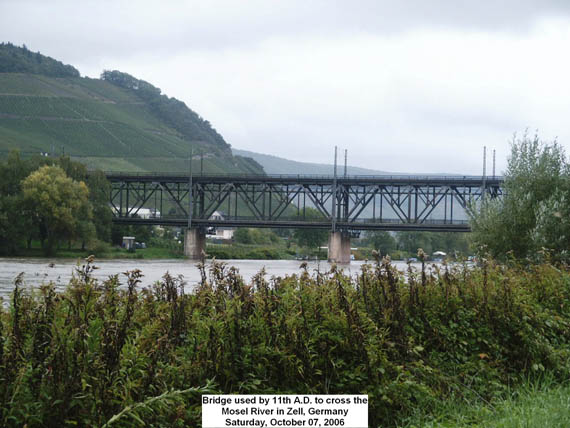 At Zell, Germany we crossed the same bridge over the Mosel River that we crossed in 1945. We also found the Worms airport that we captured in 1945. About two hours after we took the airport, the Allied airplanes started using it. We disabled two or three German planes that were at the airport and had over-head coverage for the night in a hanger.
At Zell, Germany we crossed the same bridge over the Mosel River that we crossed in 1945. We also found the Worms airport that we captured in 1945. About two hours after we took the airport, the Allied airplanes started using it. We disabled two or three German planes that were at the airport and had over-head coverage for the night in a hanger.
Today, Worms airport is a small airport for private planes and flight training.
Leaving Worms we headed to Denzlingen, Germany for more R&R. Denzlingen is near the Black Forest, just north of Freiburg.
Sunday Oct. 8th
This was another R&R day. We traveled to Triberg for sightseeing and shopping. Triberg is in the Black Forest. Some of the stores advertise over 1,000 coo coo clocks. The people were very friendly and almost all the clerks spoke English. While we were there, we had to visit a bakery and sample the Black Forest cake and apple strudel with ice cream. We ate dinner at Triberg and met three sisters from Texas who thanked my generation and me for the sacrifices we made to liberate Europe.
Monday Oct. 9th
This was another R&R day. We made a side trip to Basel, Switzerland for lunch, a little shopping and a coffee break in a sidewalk cafe.
Tuesday Oct. 10th
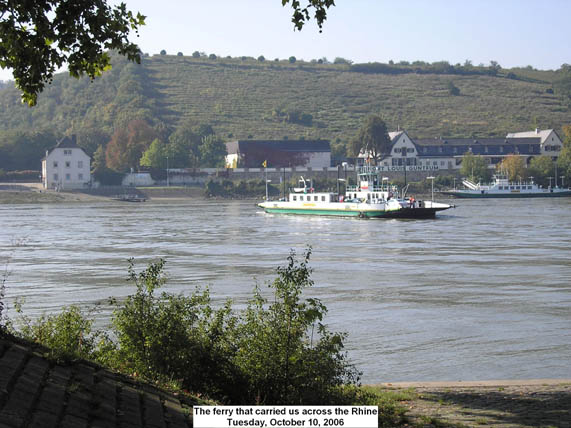 We left Denzlingen and to get back on our route, we headed back to Worms. We found the location in Oppenheim, Germany, where in 1945, we crossed the Rhine. I remember we crossed on a pontoon bridge, at night, under the cover of darkness and a smoke screen. As I recall, we didn’t waste any time crossing that pontoon bridge. Once across, our biggest obstacles were muddy roads and fields. We didn’t encounter too much resistance.
We left Denzlingen and to get back on our route, we headed back to Worms. We found the location in Oppenheim, Germany, where in 1945, we crossed the Rhine. I remember we crossed on a pontoon bridge, at night, under the cover of darkness and a smoke screen. As I recall, we didn’t waste any time crossing that pontoon bridge. Once across, our biggest obstacles were muddy roads and fields. We didn’t encounter too much resistance.
A car ferry now crosses the Rhine at Oppenheim, so on this trip, we crossed the Rhine on the car ferry to Trebur, Germany. We then headed north to Darmstadt, Hanau, Fulda, Bayreuth and Eichenzell. Again all the cities and fields were cleaned up, very well maintained, and this was good to see.
As I recall, Fulda was a place where we ran into a lot of resistance in 1945, and we bypassed it. When we arrived at Bayreuth there was a whole train of diplomats trying to avoid or escape from the Americans. Some appeared to be Japanese dressed in civilian cloths. We moved through, so I don’t know what happened to them.
On this trip we spent the night in Eichenzell, Germany
Wednesday Oct. 11th
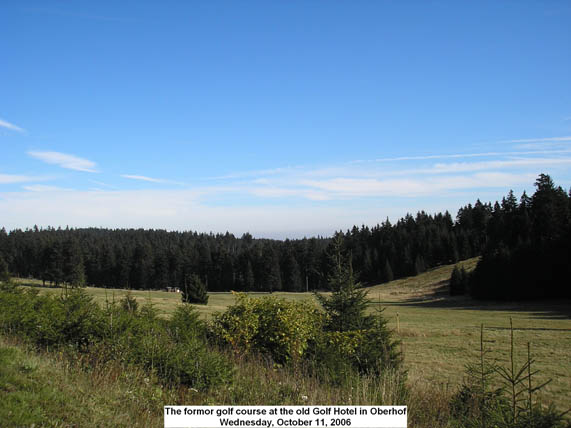 This morning we headed to Oberhof. In 1945, they said that we made 40 miles that day, but we were low on ammunition and gas, and had out-distanced our supplies. We had to wait at Oberhof for more supplies.
This morning we headed to Oberhof. In 1945, they said that we made 40 miles that day, but we were low on ammunition and gas, and had out-distanced our supplies. We had to wait at Oberhof for more supplies.
Outside of Oberhof, in 1945, there was a magnificent place called The Golf Hotel, with a golf course and ski area that was like a country club. I was hoping on this trip that we could have coffee at the hotel. I was sad to learn that this area was formerly in East Germany. From the appearance of the buildings that remain, they didn’t want anyone to have a good time. The area where the golf course was located, now looks like a cow pasture.
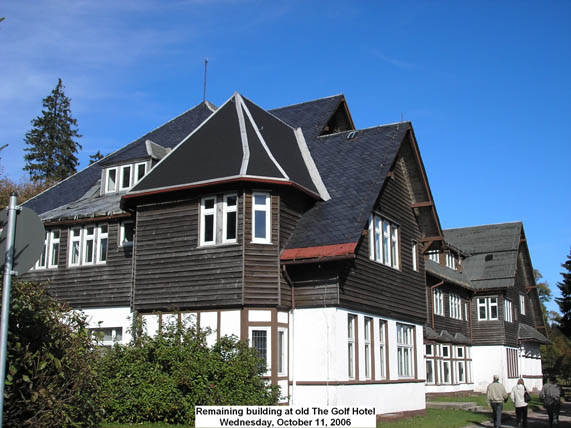 The grand hotel building that was there in 1945, is no longer there. A couple of the original smaller buildings that were next to the hotel are still there. These buildings are in poor condition, but it appears that they are being renovated. A new hotel has been built about 100 yards from the remaining original buildings. There is still snow skiing in the area and the new hotel has a health spa. The people at the new hotel were very nice. I spoke with a young lady at the new hotel and asked her when they had stopped playing golf here. She said she didn’t remember that they ever played golf here. I told her that I have a brochure of the old Golf Hotel from 1945 and promised to send her a copy. She said that would be great because then she would know what this area looked like in the past. I was disappointed at not seeing the hotel and golf course like I saw it in 1945.
The grand hotel building that was there in 1945, is no longer there. A couple of the original smaller buildings that were next to the hotel are still there. These buildings are in poor condition, but it appears that they are being renovated. A new hotel has been built about 100 yards from the remaining original buildings. There is still snow skiing in the area and the new hotel has a health spa. The people at the new hotel were very nice. I spoke with a young lady at the new hotel and asked her when they had stopped playing golf here. She said she didn’t remember that they ever played golf here. I told her that I have a brochure of the old Golf Hotel from 1945 and promised to send her a copy. She said that would be great because then she would know what this area looked like in the past. I was disappointed at not seeing the hotel and golf course like I saw it in 1945.
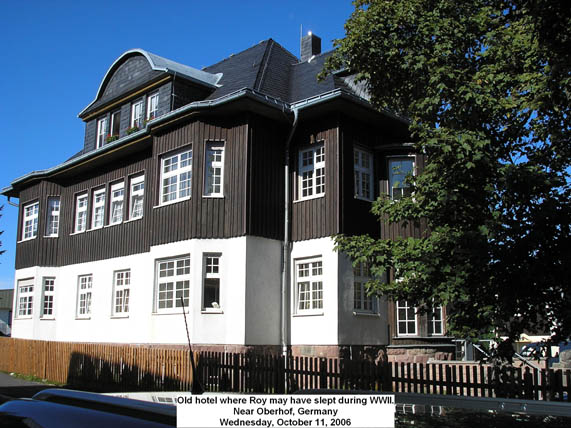 We then traveled into the town of Oberhof. In 1945, we had slept in a hotel in Oberhof. I think we found that hotel, but it was also being renovated so we were unable to go inside.
We then traveled into the town of Oberhof. In 1945, we had slept in a hotel in Oberhof. I think we found that hotel, but it was also being renovated so we were unable to go inside.
From Oberhof we headed towards Coburg, Germany. I remember in 1945, in the Coburg area, we encountered Hungarian soldiers and they gave up really easily. They were either tired of fighting or didn’t want to fight. The Germans probably forced them to “fight or be killed”.
We then headed to Roth, Germany for another R&R. Visiting Roth was very special for my grandson, Brandon, who was our driver on this trip. My son, Mark, was stationed in Germany while he was in the Army, and lived in Roth. Mark’s son, Brandon, was a baby at that time. They lived in an apartment above a house in Roth. We drove around looking for the house where Brandon had lived as a baby, but were unable to locate it.
While eating dinner in Roth, we told the restaurant staff why we had come to Roth. We gave them the lady’s name and address and they telephoned the lady, named Anna, who lived in that house. Anna was Mark’s landlord and a baby-sitter for Brandon. Anna was very excited to learn that we were in Roth and invited us to come to her home after dinner. She said she would be waiting at her gate. Anna was so excited to see Brandon she couldn’t do anything. Brandon had a smile that covered his entire body. Anna graciously served us coffee, rum, cheese and cake, and then served us wine. She offered us schnapps but we graciously declined. We also called my son, Mark, so he could talk to Anna, and she was even more excited. We were all very happy about this visit, but Brandon and Anna were extremely happy. Brandon said he only remembered her voice.
We then returned to our hotel in Roth.
Thursday Oct. 12th
We left Roth to return to our original route, heading towards Cham. In 1945, Cham is where we first ran into the atrocities of the German SS troops. The SS were shooting prisoners that were not able to walk. When we overtook them, they left their guns trying to escape. The more able bodied prisoners took those guns and pursued the SS troops. There were bodies for miles along the highway, where the SS had executed prisoners. As I recall, along this route we didn’t encounter very much resistance.
We continued on to Waldkirchen, Germany to spend the night.
Friday Oct. 13th
We left Waldkirchen and crossed into Austria. Once in Austria, we were looking for a road along the Danube River, where a pocket watch was liberated from a fire chief. We found a cable ferry that crosses the Danube in Ottensheim, that could have been the same location, but I’m not certain. While at this location, I spoke with a woman and her father. She said this ferry had been here for 90 years and she didn’t know of any other ferrys during that time. I told them that we were on our way to Mauthausen. She said her father’s father, or her grandfather, had been sent there and never came out.
We also walked around Ottensheim looking for a fire station where I had been. There is a new fire station and the one before that was built in 1950. So, we were unable to locate the fire station I remember. In 62 years, the appearance of a city and the landscape can change a lot.
We traveled on to Mauthausen and drove around the outside of the concentration camp.
Before we left for Europe, my grandson, Brandon, had emailed the Mauthausen and Gusen Commemoration Committee about our trip. They offered to provide us with tours of the Mauthausen and Gusen concentration camps.
That evening we met Siegi Witzany for dinner. She is with the Mauthausen and Gusen Commemoration Committee. She took us to a restaurant and we had a very enjoyable visit with her. Siegi had previously made reservations for our hotel at Abwinden, Austria, which is very near Mauthausen.
Saturday Oct. 14th
We picked Siegi up from her home and drove to the Mauthausen concentration camp museum. When we arrived, Siegi advised the museum staff that I was a veteran and helped liberate the camp in 1945. The museum graciously waived the entrance fee. Siegi then took us on tour, telling us about the history of the camp and the atrocities that had been committed there.
She said all the SS barracks had been dismantled. She took us into one of the prisoner barracks and said that three prisoners slept in one bed the size of a single bed. I remember, in 1945, the bunks inside the prisoner barracks went all the way to the ceiling, but they were no longer that way. She took us to the shower room, crematory, gas chamber and a room where they shot prisoners. She said that the guards for this room would be shot after a week so they could not tell what had been happening. She took us to another building that had a two-oven crematory and a morgue. The Germans would examine and mark prisoners before they were executed so they could easily identify them after they were killed in order to remove gold teeth. In the gas chamber and crematory there were pictures, memorials and flowers, placed there by family members in memory of their loved ones that had perished. She took us to a graveyard where some of the people who died after the liberation are now buried. She explained how the prisoners were processed. The average life of a prisoner was six months. She showed us the swimming pool. I remember that when I was on guard duty, there were new cloths on the far end of the swimming pool. The survivors were only wearing a single gown. The survivors were told that they could take a bath in the pool and get the new cloths. She said that there was a special place for some of the Jewish prisoners. The local town people were told that this special place was a safe house, for those people in it. In reality, these people were actually slave labor.
Siegi was questioning me about what I saw when I was here in 1945. Some of the things I told her, she had heard before--so she said, “You were here”. I told her about a cage where they would keep prisoners without any food or water, just to see how long they would survive. She said she had heard this once or twice before. I remember hearing from survivors that the commander of the camp had a dog, and sometimes he would let the dog attack a prisoner until the prisoner was dead.
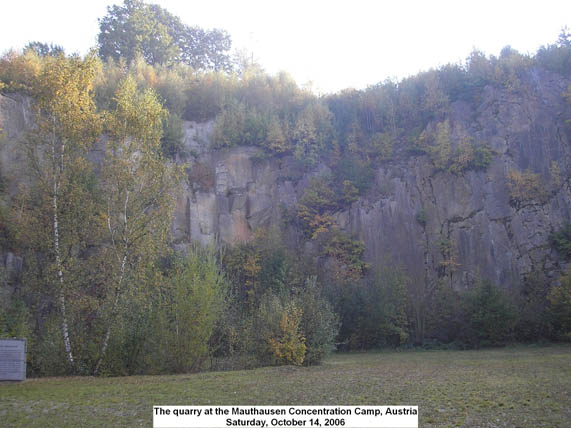 She took us to the Mauthausen rock quarry where the prisoners would have to carry large rocks on a wooden backpack up the Stairs of Death. If they couldn’t carry the load they were shot. The steps are still there, but are in a much better condition today than what the prisoners had to use. There were ponds near the walls of the quarry. The water in them had a temperature of about 40 degrees even in the summer. In 1945 I was told by some of the survivors that in the winter the guards would throw Jewish people off of the wall into these ponds. They wanted to see how long these prisoners could survive in the cold water. They did this as an experiment to see how long their pilots could live in the North Sea if they were shot down. We were also told that the guards would just push prisoners off of the walls that were 100 to 200 feet high.
She took us to the Mauthausen rock quarry where the prisoners would have to carry large rocks on a wooden backpack up the Stairs of Death. If they couldn’t carry the load they were shot. The steps are still there, but are in a much better condition today than what the prisoners had to use. There were ponds near the walls of the quarry. The water in them had a temperature of about 40 degrees even in the summer. In 1945 I was told by some of the survivors that in the winter the guards would throw Jewish people off of the wall into these ponds. They wanted to see how long these prisoners could survive in the cold water. They did this as an experiment to see how long their pilots could live in the North Sea if they were shot down. We were also told that the guards would just push prisoners off of the walls that were 100 to 200 feet high.
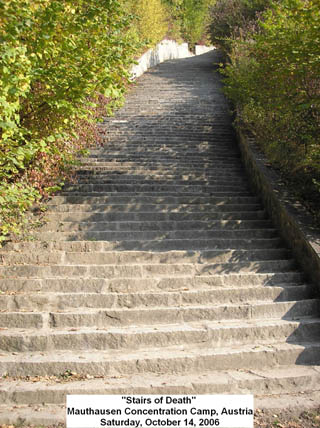 Since the quarry is now inactive, vegetation naturally grows on the quarry walls. Siegi told us that every few years the Austrian military removes the vegetation from the walls.
Since the quarry is now inactive, vegetation naturally grows on the quarry walls. Siegi told us that every few years the Austrian military removes the vegetation from the walls.
I told Siegi a story about accordions that were taken from a barge on the Danube River. She said she had heard this story before.
I was trying to see everything and remember what I had seen in 1945.
We saw a lot of memorials to the people that had been sent to these camps.
The camp really has been cleaned up since I was there in 1945. I remember that beyond the SS barracks is where there was a sports field. I remember running a foot race on this field. I ran right out of my boots and won the race in my stocking feet. This caused quite a controversy. After much discussion, I was ruled the winner since there were no rules that a racer had to wear boots in the race.
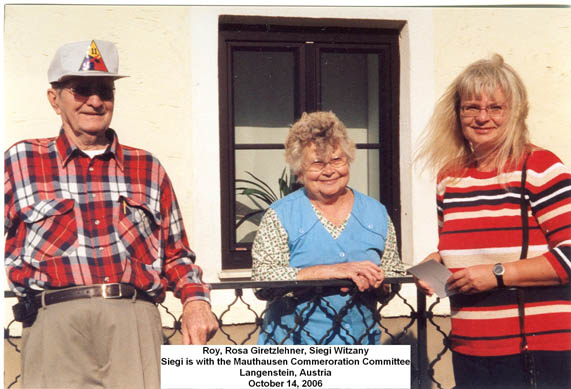 In 1945, I took a picture of a street in a town near Mauthausen. I gave Siegi a copy of that picture and she said, “I think I know this street”. We drove to the street, with Siegi providing directions. The street is the Hauptstrasse or Main Street in Langenstein, Austria. We got out of the car and walked down this street, but I wasn’t sure it was the same street. As we walked, an older woman came out of one of the houses and Siegi recognized her, saying, “Oh, there’s Rosa, I know Rosa”. She called out to Rosa and we went to meet her. Siegi introduced me to Rosa Giretzlehner and told her I was here in 1945. Rosa said she was also here and she was 17 years old in 1945. Rosa confirmed my picture was of this street. Rosa still lives on this street today. Rosa talked about the SS troops being there. She knew women that were married to SS troops. She said that they had a holiday or picnic after the Americans arrived. Then the Russians came and it was worse that when the SS were there.
In 1945, I took a picture of a street in a town near Mauthausen. I gave Siegi a copy of that picture and she said, “I think I know this street”. We drove to the street, with Siegi providing directions. The street is the Hauptstrasse or Main Street in Langenstein, Austria. We got out of the car and walked down this street, but I wasn’t sure it was the same street. As we walked, an older woman came out of one of the houses and Siegi recognized her, saying, “Oh, there’s Rosa, I know Rosa”. She called out to Rosa and we went to meet her. Siegi introduced me to Rosa Giretzlehner and told her I was here in 1945. Rosa said she was also here and she was 17 years old in 1945. Rosa confirmed my picture was of this street. Rosa still lives on this street today. Rosa talked about the SS troops being there. She knew women that were married to SS troops. She said that they had a holiday or picnic after the Americans arrived. Then the Russians came and it was worse that when the SS were there.
Rosa asked if she should go fix us something to eat. This astonished us and we were touched by her offer. We were complete strangers and she wanted to invite us into her home to eat.
Rosa said that in 1945 she was attending a funeral, and at that time, the girls and women wore all white to funerals. When they came out of the church wearing all white, the Americans thought it was a wedding, so the Americans started shouting and hollering. Then she said she saw a black soldier, and that was the first black person she had ever seen. She again offered to fix us food, but we thanked her and respectfully declined.
When we returned home, I found my old radio codebook. In that book was the name and address of the lady that did our laundry while we were there in 1945. The address was in the same town that Rosa lives in, Langenstein, Austria. I wish I had found that codebook with the lady’s name before we left. Now I wonder if Rosa knows her.
Sunday Oct. 15th
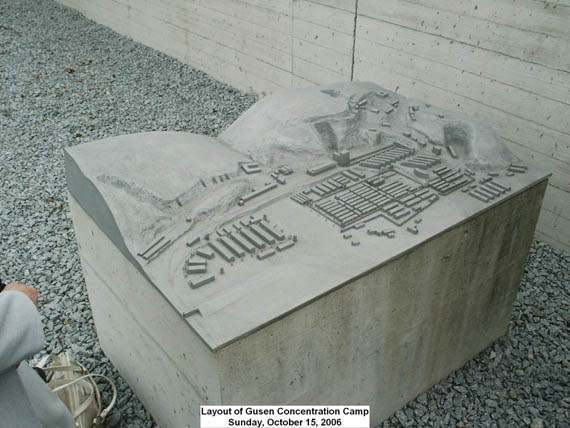 We met Martha Gammer with the Mauthausen and Gusen Commemoration Committee. Martha gave us a tour of what remains of the Gusen camp. There weren’t as many of the physical buildings left at Gusen as at Mauthausen. It appears to me that Mauthausen may have had a stronger organization to keep the Mauthausen Camp as a monument to the world, and Camp Gusen didn’t get organized until later years, so they don’t have as much of the original camp preserved.
We met Martha Gammer with the Mauthausen and Gusen Commemoration Committee. Martha gave us a tour of what remains of the Gusen camp. There weren’t as many of the physical buildings left at Gusen as at Mauthausen. It appears to me that Mauthausen may have had a stronger organization to keep the Mauthausen Camp as a monument to the world, and Camp Gusen didn’t get organized until later years, so they don’t have as much of the original camp preserved.
She described to us where the buildings of the camp had been. Inside a small museum at Gusen, Martha showed us aerial photos of the Mauthausen and Gusen area that the Allied Air Force had taken in March and April of 1945. The photos showed the Gusen Camp and the caves where they built airplanes. The Allies knew something was going on in the caves and this area from all the activity that could be seen. We saw and took a picture of the three-dimensional reproduction of the Camp Gusen layout.
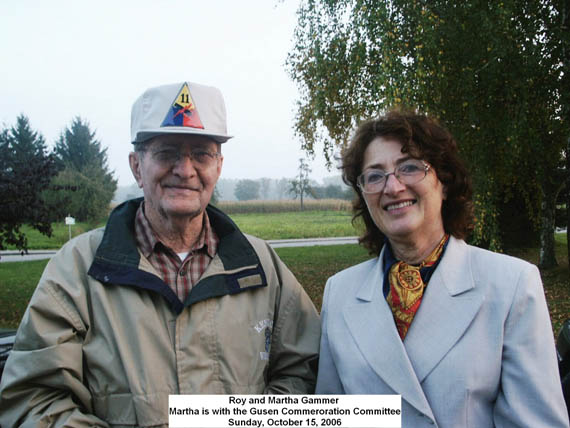 Martha said they had airplane factories in the caves between Mauthausen and Gusen. In these caves, the prisoners were forced to build Messerschmidt airplanes and other parts. In the past these caves were open to the public. However, these caves had bodies of water and a few years ago one or two people drowned inside the caves. As a result, they no longer allow the public into the caves. Martha did take us to the entrance of two or three caves. There is one area by the Gusen rock quarry that the current owner of the rock quarry wants to develop. The Gusen Commemoration Committee is fighting to keep the area as a monument and memorial. The Committee wants to keep Gusen as it is today.
Martha said they had airplane factories in the caves between Mauthausen and Gusen. In these caves, the prisoners were forced to build Messerschmidt airplanes and other parts. In the past these caves were open to the public. However, these caves had bodies of water and a few years ago one or two people drowned inside the caves. As a result, they no longer allow the public into the caves. Martha did take us to the entrance of two or three caves. There is one area by the Gusen rock quarry that the current owner of the rock quarry wants to develop. The Gusen Commemoration Committee is fighting to keep the area as a monument and memorial. The Committee wants to keep Gusen as it is today.
Martha told us that at Gusen, slave labor was used to change the course of a small river. This river is about one quarter of a mile from the Danube. They changed the course of the river in order to build a harbor at the Gusen camp. There was a big house on top of a hill that was the commander’s house. The plan was to herd all the prisoners into the caves and blow them up. The explosives were controlled from that commander’s house. However we came in so fast, they didn’t have time to do this. As we arrived, the guards starting escaping, trying to get away. If I remember correctly, there was one railroad that ran into Gusen.
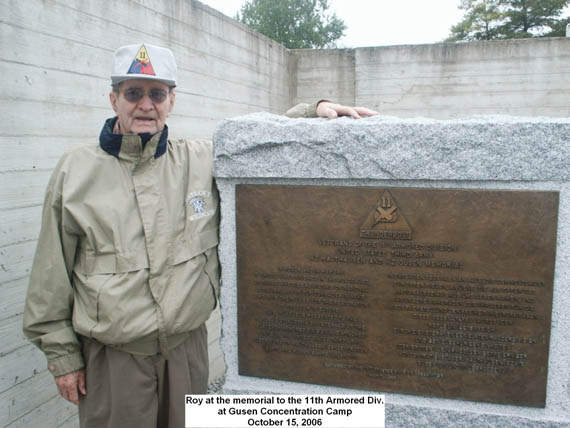 We also saw and I had my picture taken at the monument to the 11th Armored Division at Gusen.
We also saw and I had my picture taken at the monument to the 11th Armored Division at Gusen.
We had lunch with Martha at the same restaurant where we had dinner with Siegi last night. Martha told us that this was a restaurant where the German SS troops ate in the 1940s.
Martha then took us to look for a stream or small river that connected to the Danube in an area past Mauthausen. I was looking for the area where we had met the Russian forces on May 8, 1945. At that time we had orders not to advance any further than this stream. This was the farthest east that we went during the war. I was not able to identify the stream or this area. While looking for this stream, Martha took us for a tour of a beautiful church in Baumgartner, Austria. This church was formerly a convent, and now functions as a school, and home for girls that have been in trouble.
We again want to thank Siegi and Martha for taking the time to guide us through the Mauthausen and Gusen concentration camp memorials. We really appreciated their kindness and the information they provided, and really enjoyed our time with them.
Monday Oct. 16th
We left Mauthausen, and drove through the Austrian Alps on the way to Spittal, Austria. In 1945, we were stationed in Spittal after we had left Mauthausen. I’m sure I’ve seen these mountains before, but it was in the spring and summer of 1945, and this time we were traveling during autumn.
We had a beautiful drive to Spittal on the Autobahn.
In Spittal, I remember a fast flowing stream that ran through the town. The stream is still flowing fast, even after nearly 62 years. The people in Spittal were very friendly.
One thing I remember about Spittal, was a woman whose husband was said to be an SS
trooper. They had twin boys that were about four or five years old. We would offer these boys food--one would take it and the other would not. In the short period of time that we were there, you could see that the one that took food gained about seven or eight pounds. The other boy would eat as they were walking away, but not eat in front of us. But since the boy that ate in front of us ate most of the food, there wasn’t much left for the other one.
Since Spittal was so close to Italy, and since I did not go to Italy in 1945, we made a quick trip to Italy.
After turning around in Italy, we headed back north, to find that the authorities had closed the Autobahn due to some cracks they found. So north of Spittal, we had to seek out an alternative route. Driving through the mountains, the roads became smaller and narrower and we came across the town of Mallnitz, Austria. At Mallnitz, we learned that there was a train that would take us past the closed section of Autobahn. So, we drove our car onto a flat rail car, and took a train ride around and through tunnels in the mountains to rejoin the Autobahn. We drove until the early hours of the morning on our way to Rothenburg ob der Tauber, Germany.
Tuesday Oct. 17th
We spent another R&R day in Rothenburg ob der Tauber, Germany sightseeing and shopping.
Wednesday Oct. 18th
After a little more sightseeing and shopping we departed Rothenburg ob der Tauber, Germany for Frankfurt to prepare for our trip back home.
Thursday Oct. 19th
We departed Frankfurt, Germany, connecting through Detroit and returning to St. Louis. We all returned home safely and were thankful for the opportunity to share this trip with each other.
Conclusions:
In 1944-45, the trip was something that had to be done. I played a small part in doing it and the people we met thanked me for it.
The trip that I just concluded was a most enjoyable and a great trip. There was a different atmosphere, a different climate, and everything was different.
On this trip, you didn’t have to wonder if you would be shot at. We received smiles from almost all the people we met.
I’m glad I got to go back and to see that the people and the next generation repaired their countries and started living normal lives.
Something good happened every day on this trip. To commemorate our historic trip, we have over 1,200 pictures, eight hours of video and numerous stories to share with family and friends.
I am especially grateful to my two daughters and grandson who accompanied me on this trip. Their presence made this trip very special for me.
|